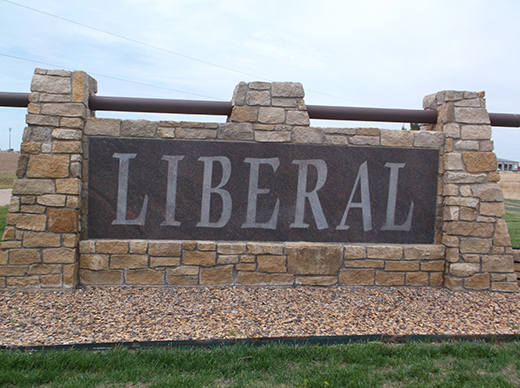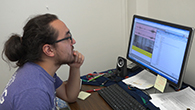A Liberal accent: Linguistics team documents language changes in southwest Kansas
Monday, June 11, 2018
Mary Kohn, Kansas State University associate professor of English, explains some of the language changes that her research team has observed in Liberal, a community in southwest Kansas.
MANHATTAN — Language changes are happening in southwest Kansas, a Kansas State University linguistics team has found. People in Liberal and other communities are developing a distinct accent, and the language change is a sign of a vibrant and growing community, researchers say.
Mary Kohn, associate professor of English, and her research team, including Trevin Garcia, May graduate in English, Liberal, have found that as demographics have changed and Latino populations have increased in southwest Kansas, the ways that people are speaking English have changed, too.
"A lot of these patterns are on the phonetic level, meaning that it deals with sounds," Kohn said. "So what we are dealing with here is a distinct accent. It's not so much that we have completely radical new ways of speaking in Liberal, as it is there is a distinctive Liberal sound that is emerging."
That distinct Liberal sound is most prominent among young people, Kohn said. Many youth — even those who do not speak Spanish — speak English with subtle Spanish characteristics, such as rhythmic or staccato syllables and different vowel pronunciations. These changes are especially noticeable in words, such as "cat" or "hand."
In this audio sample, Mary Kohn, Kansas State University associate professor of English, explains some of the language changes that her research team has observed in the southwest Kansas community of Liberal. | Download this audio clip.
This audio sample illustrates pre-nasal raising. The young European American male speaker from Liberal says his English vowels — especially the word "Spanish" — in a Spanish-style pronunciation. | Download this audio clip.
Kohn's research is part of the Kansas Speaks Project, which she began to document language change throughout the state. Her team is focusing on southwest Kansas because of the rapid demographic changes in the area since the 1980s. Communities such as Liberal went from a 20 percent Latino population to a 60 percent Latino population over a couple of decades, Kohn said.
"For us, it's just really exciting to watch these demographic shifts happening," Kohn said. "There are changes to the demography of the region and there are linguistic changes as well. It's a real testing ground of what happens when you bring different language backgrounds together within a community in an immediate and present way."
Kohn's team is building a corpus — or collection — of audio samples that represent the ways that people talk in different Kansas communities. Throughout the state, they have interviewed more than 90 people ranging from 8 years old to 91 years old. They are comparing these present-day interviews with about 20 archival interviews conducted in 1968 in 10 different Kansas communities by the Dictionary of American Regional English.
What is happening in Liberal is similar to what has happened in other regions in the U.S. Look at Minnesota, Kohn said, where the iconic Minnesota accent developed through northern European immigration to the region.
"It's something that we see all over the U.S., and it's characteristic of what happens when you have large immigration patterns affect the demographic of the region," Kohn said.
Through their collections, the researchers have found that the Latino English that is emerging in southwest Kansas shares certain links and patterns with other rural communities in Texas, California, New York and Florida. All of these communities are experiencing rapid demographic shifts and increases in Latino populations.
But unlike other communities across the country, younger European Americans in southwest Kansas are beginning to speak English that mimics the staccato, rapid and evenly timed sounds of Spanish, Kohn's research has found.
This audio sample illustrates syllable timing. The speaker is a young European American male from Liberal and his English pronunciation mimics the even syllables of Spanish. | Download this audio clip.
For Kohn and the Kansas Speaks Project, it is exciting to see a new English sound emerging in these communities. English is not threatened, Kohn said, because language change is natural as each generation finds its own voice.
"There has always been this fear that language change is somehow dangerous or scary or will prevent communication," Kohn said. "When we see language change, what we really see is that a community is continuing to develop and grow. It's a sign that we have a vibrant and lively community present. The only kind of language that doesn't change is a dead language."
Kohn is presenting the research on Kansas English at the Sociolinguistics Symposium 22 in New Zealand later in June.
Sidebar
Undergraduate researchers have been tremendously important to the Kansas Speaks Project. The project is documenting language change throughout the state and has received support from Kansas State University's College of Arts and Sciences and Developing Scholars Program.
Trevin Garcia, Kansas State University May graduate in English, Liberal, devoted his undergraduate research project to documenting linguistic changes in Liberal. He conducted interviews with people in the community and analyzed the results under the direction of Mary Kohn, associate professor of English.
For Garcia, the project has been a way for him to build on his love of linguistics and prepare for graduate school.
"Undergraduate research lets students go beyond what they would be learning in class and lets them apply it or investigate topics maybe they wouldn't cover in class," Garcia said.
Garcia received a prestigious University Graduate Fellowship at the University of Kansas and will be starting graduate work in linguistics in the fall semester.



